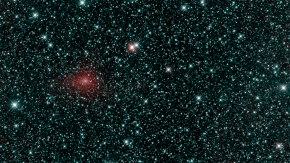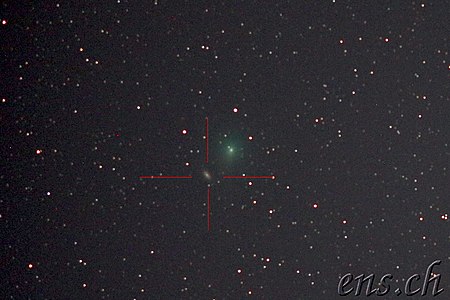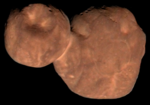For the 2013 and 2020 comets of the same name, see C/2013 E2 (Iwamoto) and C/2020 A2 (Iwamoto).
 Comet Iwamoto as seen from the infrared telescope NEOWISE on 25 February 2019 Comet Iwamoto as seen from the infrared telescope NEOWISE on 25 February 2019 | |
| Discovery | |
|---|---|
| Discovered by | Masayuki Iwamoto |
| Discovery date | 18 December 2018 |
| Orbital characteristics | |
| Epoch | 3 March 2019 (JD 2458545.5) |
| Observation arc | 348 days |
| Number of observations | 2,771 |
| Aphelion | 287.25 AU |
| Perihelion | 1.287 AU |
| Semi-major axis | 144.27 AU |
| Eccentricity | 0.9911 |
| Orbital period | 1,733 years |
| Inclination | 160.40° |
| Longitude of ascending node | 147.48° |
| Argument of periapsis | 358.06° |
| Last perihelion | 7 February 2019 |
| TJupiter | –1.286 |
| Earth MOID | 0.299 AU (44.7 million km) |
| Jupiter MOID | 1.507 AU (225.4 million km) |
| Comet total magnitude (M1) | 13.6 |
C/2018 Y1 (Iwamoto) is a long period comet with a retrograde orbit discovered on December 18, 2018, by Japanese amateur astronomer Masayuki Iwamoto. Its period is estimated to be 1,733 years. It passed closest to Earth on February 13, 2019. It was expected to reach a magnitude of between 6.5 and 7.5, visible in binoculars or a small telescope and was reported to reach a magnitude of 5.5 by Juan Jose Gonzalez on February 13, before fading to 7.6 two weeks later.
The comet was observed by iSHELL spectrograph at the NASA Infrared Telescope Facility (IRTF). Overall, the measured spatial distributions for polar molecules (in particular, H2O and CH3OH) were broader, exhibiting more complex structure compared with nonpolar or weakly polar species (CH4, C2H6, and CO). Compositionally, compared to their respective mean abundances among comets from the Oort cloud, C2H6 and CH3OH were enriched, CH4 and HCN were near normal, and all other species were depleted. The abundance ratio CH3OH/C2H6 was higher by 45% ± 8% on January 13 versus February 5, whereas CH4/C2H6 was unchanged within the uncertainty, suggesting nonhomogeneous composition among regions of the nucleus dominating activity on these dates.
Gallery
-
 Animation of C/2018 Y1 orbit
Animation of C/2018 Y1 orbit
Mercury · Venus · Earth · Mars · C/2018 Y1 -
 Animation of C/2018 Y1 orbit 1600-2500
Animation of C/2018 Y1 orbit 1600-2500
Sun · Uranus · C/2018 Y1 -
 Comet C/2018 Y1 (Iwamoto) with M44, 13. February 2019, 23:04 Uhr
Comet C/2018 Y1 (Iwamoto) with M44, 13. February 2019, 23:04 Uhr
-
 Comet C/2018 Y1 (Iwamoto) with the spiral galaxy NGC 2903, 13 February 2019, 23:19 Uhr
Comet C/2018 Y1 (Iwamoto) with the spiral galaxy NGC 2903, 13 February 2019, 23:19 Uhr
-
 Comet C/2018 Y1 (Iwamoto) with nebulae IC 410 and IC 405
Comet C/2018 Y1 (Iwamoto) with nebulae IC 410 and IC 405
See also
References
- ^ James, Nick. "C/2018 Y1 (Iwamoto) - A new comet for the new year". Britastro.org. Retrieved 2 February 2019.
- "C/2018 Y1 (Iwamoto) – JPL Small-Body Database Lookup". ssd.jpl.nasa.gov. Jet Propulsion Laboratory. Retrieved 15 October 2022.
- ^ "Speedy comet approaching Earth's vicinity". Earth & Sky. Retrieved 2 February 2019.
- Hanneke Weitering (12 February 2019). "How to See Comet Iwamoto Fly Past Earth This Week". Space.com. Retrieved 15 October 2022.
- "Weekly Information about Bright Comets (2019 Mar. 2: North)". www.aerith.net. Retrieved 15 October 2022.
- DiSanti, Michael A.; Bonev, Boncho P.; Dello Russo, Neil; McKay, Adam J.; Roth, Nathan X.; Saki, Mohammad; Gibb, Erika L.; Vervack Jr., Ronald J.; Khan, Younas; Kawakita, Hideyo (9 November 2021). "Volatile Composition and Outgassing in C/2018 Y1 (Iwamoto): Extending Limits for High-resolution Infrared Cometary Spectroscopy between 2.8 and 5.0 μm" (PDF). The Planetary Science Journal. 2 (6): 225. Bibcode:2021PSJ.....2..225D. doi:10.3847/psj/ac07ae. ISSN 2632-3338. S2CID 229008642.
 This article contains quotations from this source, which is available under the Creative Commons Attribution 4.0 Unported (CC BY 4.0) license.
This article contains quotations from this source, which is available under the Creative Commons Attribution 4.0 Unported (CC BY 4.0) license.
External links
- C/2018 Y1 at the JPL Small-Body Database
| 2019 in space | ||
|---|---|---|
| Space probe launches |
|    |
| Impact events |
| |
| Selected NEOs | ||
| Exoplanets |
| |
| Discoveries |
| |
| Comets | ||
| Space exploration |
| |
This comet-related article is a stub. You can help Misplaced Pages by expanding it. |

